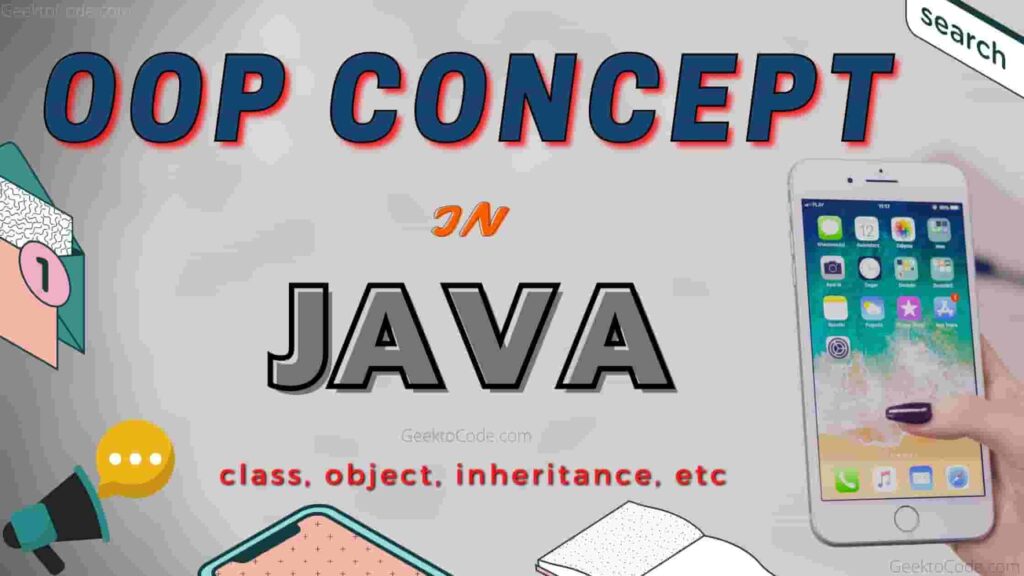Good day, readers. We will talk about the OOPs concept in java in today’s topic. Before writing a Java program, it is essential to understand these fundamental ideas. Before these, we also covered decision-making, loop control, and Java methods in case you missed them. Now, hurry up! Other Java-related topics, including Difference between C++ & Java, Operators in Java, Data Types in Java, and many others, have also been briefly discussed in the past. This information will be very helpful to your understanding. So let’s get to the point without further hesitation:
What are OOPs in Java?

Object-oriented programming is known as OOP. It is a style of programming that is based on the idea of “objects,” which can hold both data and methods. Increasing the program’s flexibility and maintainability is the main goal of object-oriented programming. The goal of object-oriented programming is to make the code concise and simple to comprehend while also attempting to map code instructions to the real world. To ensure that you have no trouble grasping OOPs concepts, we will go over every feature of OOPs in detail.
“Object Oriented Programming,” as the term is commonly known and used, is a key idea in contemporary programming languages like Java. A modular strategy where objects—individual units made up of data and functions—can be created. It places an emphasis on data and security and offers code reuse. We can make our code look like real-world code by using OOP. While object-oriented programming creates objects that contain both data and methods, procedural programming involves writing procedures or methods that perform operations on the data.
- One of the most common strategies in programming is to solve a problem by creating objects.
- Creating objects, reusing them throughout the program, and manipulating these objects to achieve results is the fundamental idea behind OOPs.
- The goal of object-oriented programming is to incorporate programming real-world concepts like inheritance, polymorphism, abstraction, encapsulation, etc.
- OOP’s primary goal is to connect the data and the methods (functions).
OOPs Concepts In Java
• Object
• Class
• Abstraction
• Inheritance
• Polymorphism
• Encapsulation
Object
In an object-oriented system, an object is a runtime entity; typically, we refer to an object as an instance of a class. Each object has unique qualities and characteristics. The fundamental elements of OOP are objects, which are examples of classes.
Class
The group of objects is referred to as a class. It is not a physical entity; it is merely a logical component. For creating objects, classes resemble object constructors. Classes don’t take up any memory space. A class is also referred to as an object’s template. Members of classes can be fields, methods, or constructors. Both static and instance initialize are present in a class. A class can also be thought of as a template from which an individual object can be built.
Abstraction
With abstraction, you “hide” unneeded information from the user and only display “relevant” information. We can say that data hiding is abstraction’s primary goal. It is a method for developing a brand-new data type that is appropriate for a particular application. Classes are used for abstraction in Java. As a result, it is also known as an “abstract data type.”
For instance, when you log into your bank account online, what happens after you press login, how the input data is sent to the server, and how it is verified, are all abstracted away from you. You can learn more about it here: Java Abstraction.
Inheritance
One of the fundamental ideas of OOPs is inheritance, which describes how one object takes on the behavioral patterns of its parent object. It enhances the relationship of parent and child between the two classes. The idea behind this is that we can build new classes on top of older classes; in other words, when you inherit from an older class, you can use its fields and methods again. It provides a reliable and organic mechanism for structuring and organizing any software.
Polymorphism
Here, “Poly” refers to “Many” and “Morphism” refers to “Form.” The ability of a variable, object, or function to take on multiple forms is one of Java’s OOP concepts. It’s referred to as polymorphism. It happens when there are numerous classes connected by inheritance. One interface and many methods are common ways to express the concept of polymorphism. It is one of the key OOPs principles.
Encapsulation
Encapsulation is the process of combining data (class variables) and function (method) into a single entity (class). Encapsulation means making sure that private information is protected from users. Only the methods of their current class can be used to access it. The data is kept secret from other classes during this process and is only accessible through the methods of the current class. Thus, it is also referred to as data hiding. Encapsulation serves as a barrier that keeps outsiders from accessing the code and data.
Advantages of OOPs Concept
- OOP is quicker and simpler to use.
- The program’s structure is made clear by OOP.
- Don’t Repeat Yourself (DRY) advice from OOP makes it simpler to maintain, modify, and debug Java code.
- OOP allows for quicker development times and less code needed to create fully reusable applications.
- The main components of Java’s OOPs concepts include reusability, data redundancy, code maintenance, security, ease of troubleshooting, and design benefits.
NOTE:- ‘Don’t Repeat Yourself’ (DRY) is a programming principle that aims to minimize code repetition. Instead of repeating the same code over and over again, you should extract the parts that are common to the application and put them in one location.
Thus, the primary subject of this article is Java’s OOPs concept. I sincerely hope you can use this. Wait for this to meet in the next post, where we will discuss a brand-new aspect of Java. Thanks a lot.



